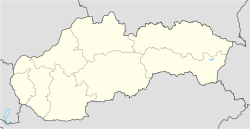Holiare
Gellér | |
|---|---|
Village | |
 Municipal office | |
| Coordinates: 47°50′N 17°49′E / 47.833°N 17.817°E | |
| Country | Slovakia |
| Region | Nitra |
| District | Komárno |
| First mentioned | 1257 |
| Government | |
| • Mayor | György Kürthy (SMK-MKP) |
| Area | |
| • Total | 9.88[2] km2 (3.81[2] sq mi) |
| Elevation | 110[3] m (360[3] ft) |
| Population (2021) | |
| • Total | 459[1] |
| Postal code | 946 16[3] |
| Area code | +421 35[3] |
| Car plate | KN |
| Website | https://www.holiare.sk/ |
Holiare, until 1948 Gelér (Hungarian: Gellér, Hungarian pronunciation:[ˈɡɛlleːr]) is a village and municipality in the Komárno District in the Nitra Region of south-west Slovakia.
YouTube Encyclopedic
-
1/3Views:54 5606 85816 864
-
Manipuri girls play balloon wrecking game
-
Manipuri Comedian Joseph and troupe mimicking actors and singers
-
Eco Friendly Holi Colours | Mocomi Kids
Transcription
Geography
The village lies at an altitude of 112 metres and covers an area of 9.885 km². It has a population of about 415 people.
History
In the 9th century, the territory of Holiare became part of the Kingdom of Hungary. In historical records the village was first mentioned in 1257. After the Austro-Hungarian army disintegrated in November 1918, Czechoslovak troops occupied the area, later acknowledged internationally by the Treaty of Trianon. Between 1938 and 1945 Holiare once more became part of Miklós Horthy's Hungary through the First Vienna Award. From 1945 until the Velvet Divorce, it was part of Czechoslovakia. Since then it has been part of Slovakia.
Demographics
The village is about 94% Hungarian, 6% Slovak.
Facilities
The village has a public library, and a football pitch.
Genealogical resources
The records for genealogical research are available at the state archive "Statny Archiv in Bratislava, Slovakia"
See also
References
- ^ "Počet obyvateľov podľa pohlavia - obce (ročne)". www.statistics.sk (in Slovak). Statistical Office of the Slovak Republic. 2022-03-31. Retrieved 2022-03-31.
- ^ a b "Hustota obyvateľstva - obce [om7014rr_ukaz: Rozloha (Štvorcový meter)]". www.statistics.sk (in Slovak). Statistical Office of the Slovak Republic. 2022-03-31. Retrieved 2022-03-31.
- ^ a b c d "Základná charakteristika". www.statistics.sk (in Slovak). Statistical Office of the Slovak Republic. 2015-04-17. Retrieved 2022-03-31.
- ^ a b "Hustota obyvateľstva - obce". www.statistics.sk (in Slovak). Statistical Office of the Slovak Republic. 2022-03-31. Retrieved 2022-03-31.
External links


